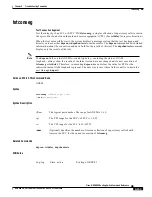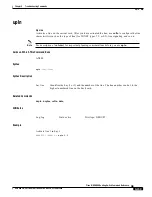
9-148
Cisco MGX 8850 Routing Switch Command Reference
Release 2.0, Part Number 78-10467-04 Rev C0, October 2001
Chapter 9
Troubleshooting Commands
pathtraceport
pathtraceport
Call Control Operations: Enable/Disable Path Trace at Port Level
Enables (disables) path trace feature at port level, then saves the result of the path trace in the log file.
Cards on Which This Command Runs
PXM45
Syntax
pathtraceport <portid>
{enable | disable}
[-H {on | off}]
[-CB {on | off}]
[-V {on | off}]
[-CR {on | off}]
[-cldnum called-AESA]
[-clgnum calling-AESA]
Syntax Description
portid
The portid represents the PNNI logical port and has the format
[shelf.]slot[:subslot].port[:subport]. See also
PNNI Format, page 9-3
.
enable | disable
Enables (disables) path trace at port level.
-H
Specifies the hierarchy option. If enabled, information from all the DTLs in
the hierarchy are added in the TTL IE.
Default = off
-CB
Specifies the crankback option. If enabled, the failure cause for crankback is
included in the TTL IE.
Default = on
-V
Specifies the VPI/VCI option. If enabled, VPI/VCI values of the egress port
are added in the TTL IE at every node.
Default = off
-CR
Specifies the call reference option. If enabled, call reference values of all
egress ports are added in the TTL IE.
Default = off
-cldnum
Specifies the called party number. Enables (disables) path trace on a specific
called address.
-clgnum
Specifies the calling party number. Enables (disables) path trace on a specific
calling address.
















































